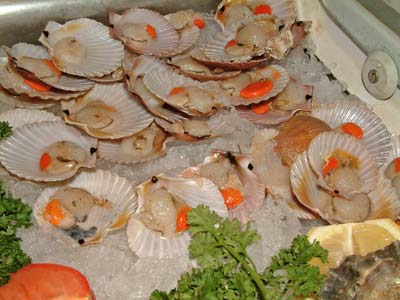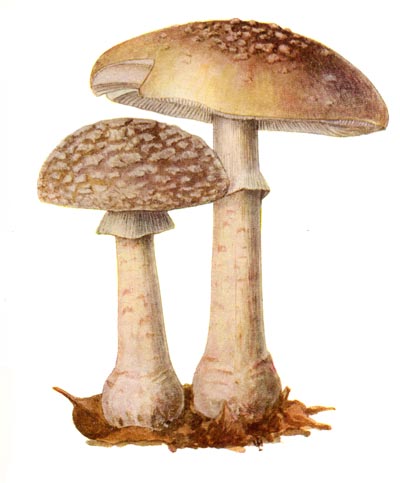Young amberjack. A large, round blue fish with yellow markings and lean, mild flesh found in the Mediterrean, tropical and sub-tropical waters and off the South Atlantic coast of North America. The amberjack does not gather in shoals and quality varies.
Man on horseback. A type of pleasant edible mushroom of yellowish colour with which some cases of poisoning have been recorded.
Man on horseback. A type of pleasant edible mushroom of yellowish colour with which some cases of poisoning have been recorded.

Pilgrim or great scallops. These are shellfish with white meats and pink corals, often cooked in their shells with the corals and have sweet, succulent meat if properly cooked. According to legend, the body of St James (St-Jacques) travelled with a boat with neither oars nor sails around the Iberian coast, coming to rest in Compostela. Many miracles were associated with this journey, including one where the horse of a pagan nobleman leaped into the sea. They emerged carrying the body of St James covered in scallop shells. This resulted in the nobleman converting to Christianity. Pilgrims to Santiago de Compostela have traditionally worn scallop shell badges in commemoration of St James, or used scallop shells as begging bowls. The whole pilgrim route is decorated with his emblem. In some parts of Europe they are eaten on the feast day of St James on 25 July to commemorate the arrival of pilgrims or peregrinos at Santiago de Compostela, often with tomatoes and garlic. They are more often simply and lightly fried.

The blusher. The one problem with this mushroom is that, whilst edible itself, it closely resembles others that are poisonous, including the death cap. It must be cooked as it contains a toxin which is destroyed by heat, like kidney beans. The most identifiable thing about it is that this reddish brown mushroom with pinkish grey scales and a white stem colours pink to red at sites of damage or bruising. The gills and flesh are white, also becoming red or pink on bruising. It is most commonly found in beech woods in summer to late autumn (US: fall). Also look closely at the ring on the stem. This should have lots of fine grooves on its upper side, unlike another poisonous mushroom which it closely resembles, the panther cap.